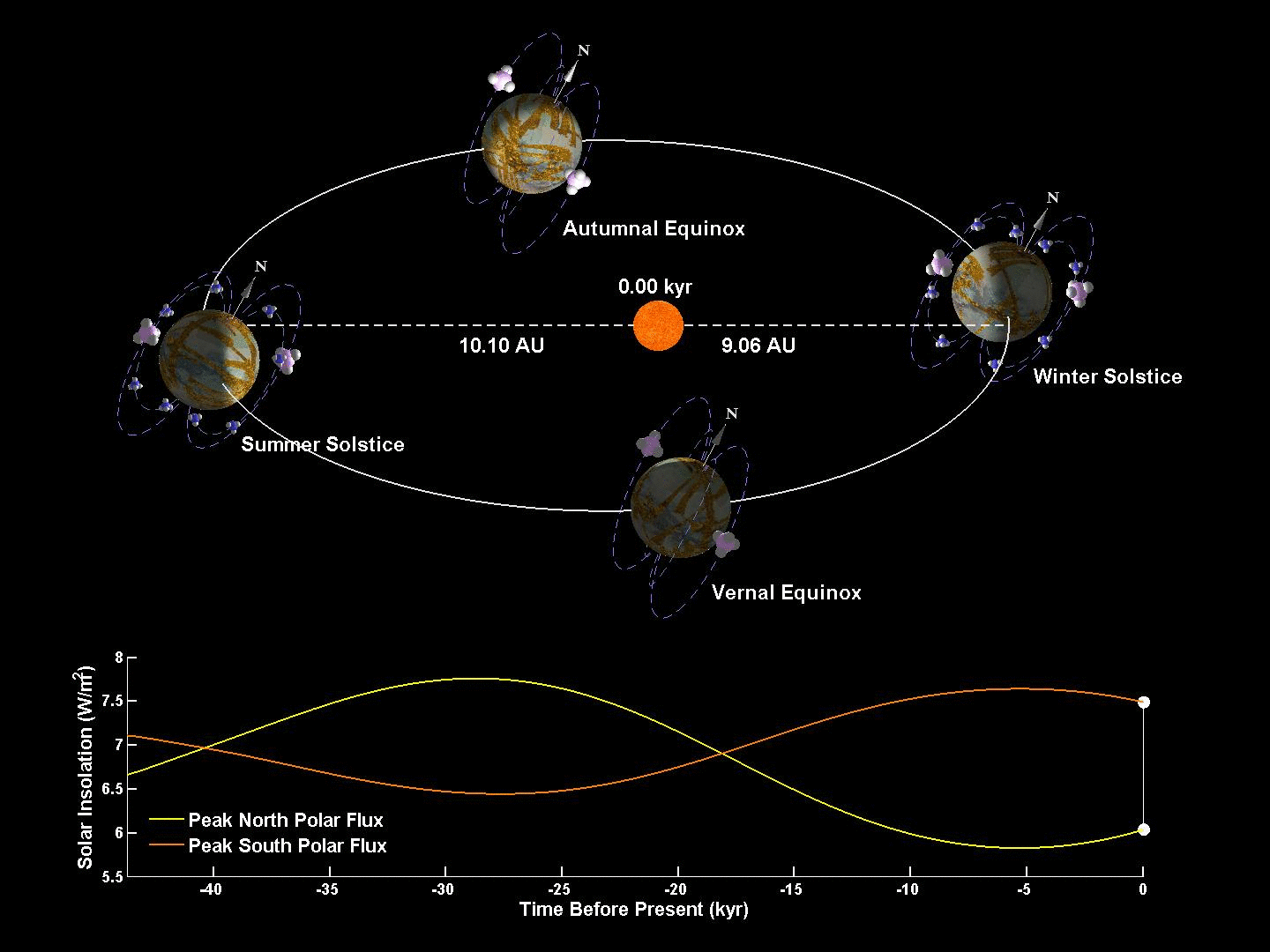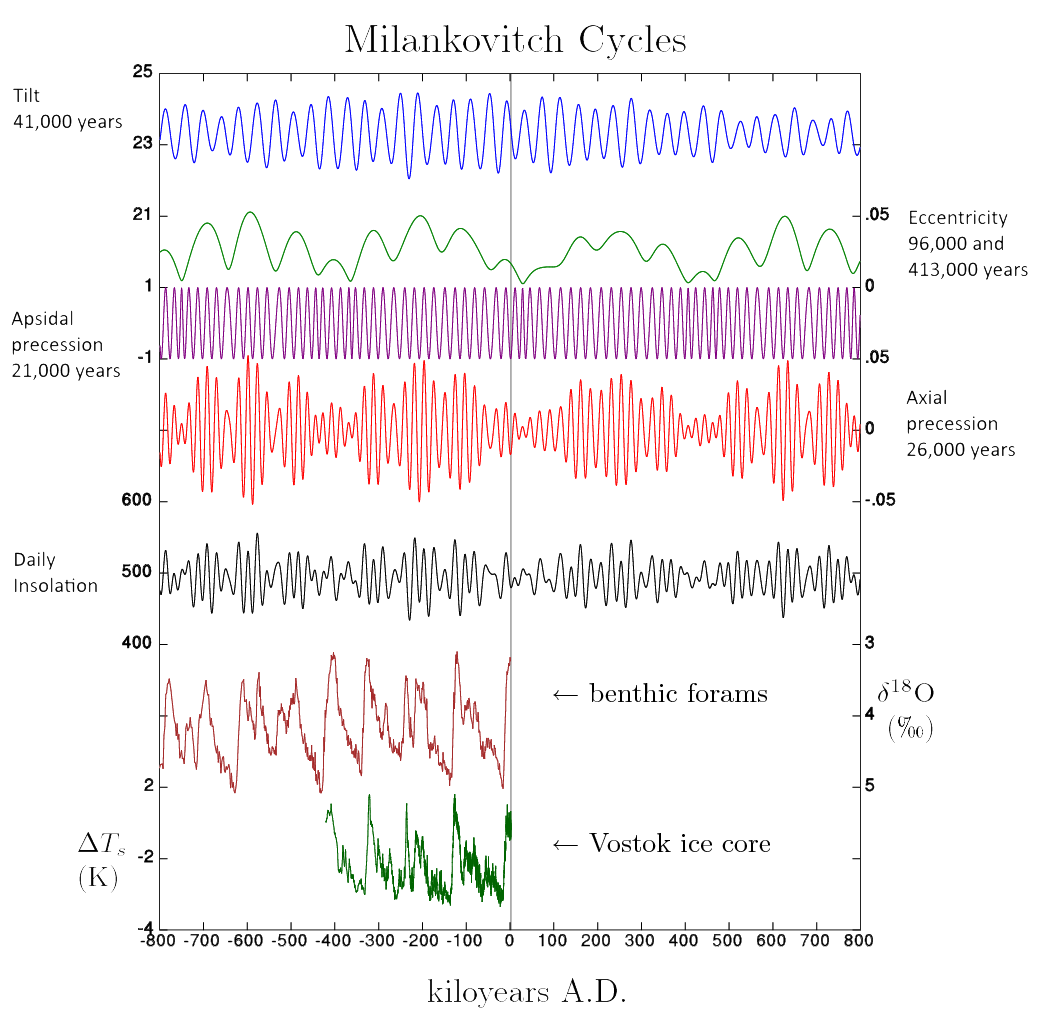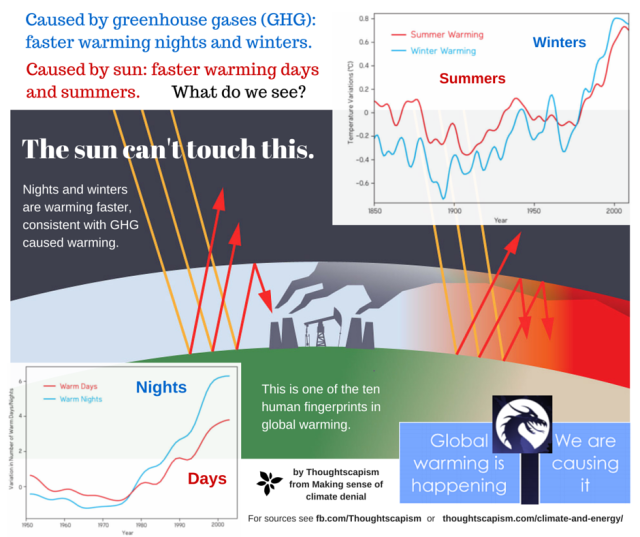In parts I and II, we looked at axial obliquity, axial precession, apsidal precession, orbital eccentricity and orbital inclination, and how their cycles can affect the climate. In this installment of the series, we’ll look briefly at how these cycles look when combined, and then discuss one of the most prominent unsolved problems raised by the theory: The 100,000 Year problem.
Notice that the peaks and valleys in temperature are roughly periodic, and that with the possible exception of apsidal precession, there are slight fluctuations in the periods and amplitudes of these orbital cycles. One reason for this has to do with fluctuations in solar output, but another likely reason has to do with the very causes of these orbital cycles themselves: namely, these cycles are driven by mutual gravitational perturbations between the Earth, Sun, Moon, and to a lesser extent, Jupiter and the other planets in the solar system (Borisenkov 1985, Spiegel 2010) .
These are what are referred to in physics as “n-body problems.” Isaac Newton recognized early on that some such orbital fluctuations would have to occur, but it turns out that n-body problems cannot be solved analytically for systems of n ≥ 3 (Heggie 2005). That means the resultant systems of differential equations has to be solved using what are called numerical methods, rather than being solved for a set of analytic functions describing the precise trajectories of each body in the system over time. As a result, the actual precise paths that celestial bodies take and the variations in their tilt and precession can be more complex than just a fixed elliptical path. To add insult to injury, these problems become even more complicated in General Relativity than in classical Newtonian Celestial Mechanics.

Milankovitch Cycle/Insolation animation¹ c/o Caltech
I want to also emphasize the fact that even though Milankovitch first proposed his ideas nearly a century ago, this is still an area of active research. There are still unsolved questions about how these cycles combine to help produce the glaciation data we see in the paleo-climatological records. For instance, there’s what is known as The 100,000 Year Problem. This refers to the fact that during the past million years, glacial-interglacial periods have occurred on roughly a 100,000 year cycle, which has been difficult to reconcile with the fact that the insolation changes due to the 100,000 year orbital eccentricity cycle are very small. The effect appears to exceed the magnitude of the cause.
There is no shortage of plausible hypotheses, each with their respective strengths and weaknesses, but as of yet there’s still no unified theory that explains how precisely the cycles all work together to produce the observed pattern of glacial and interglacial periods.
For instance, researchers such as Muller et al have hypothesized that orbital inclination may be more important in producing the observed 100kyr glaciation cycle than the other cycles (Muller 1997). The only physical mechanism thus far proposed for this is the possibility that different inclinations of the orbital plane may correspond to different densities of meteoroid and dust accretion. Such a change could alter stratospheric concentrations of dust and aerosols, which would change the amount of sunlight reflected back into space. So far there’s no evidence for sufficiently different amounts of accretion at different orbital inclinations for this to be the case, but it’s a testable hypothesis whose strengths and weaknesses are outlined by the lead author here (Muller 1995).
Other researchers have been able to reproduce the 100,000 year cycles in models involving the non-linear phase locking of interactions between the known orbital forcings and internal oscillations in the climate system (Tziperman et al 1997). The basic idea behind the non-linear phase locking models is that axial obliquity and/or precession may act as pacemakers for the glaciation cycle in a manner that is distinct from models based on mere amplifications of the effects of the eccentricity cycle.
The minutia of the actual physical mechanisms involved in the non-linear phase locking models is left quite vague. No definite conclusion is attempted regarding whether the dominant cycle is obliquity, precession or both; the models work just as well with CO2 changes driving glaciation in synchrony with the orbital cycles as they do with the orbital cycles driving them with CO2 changes merely amplifying the signal. But that’s because the goal with that paper was merely to figure out whether such models could reproduce the cycle. The same lead author (Tziperman) has also co-authored work that explored a sea ice triggering mechanism for glaciation (Gildor 2000).
Others have even argued that the last 800,000 or so of climate records extends insufficiently far back to establish that the apparent 100,000 year glaciation cycle and its relationship to the eccentricity cycle are even statistically significant (Wunsch 2004).
This is not the only unresolved problem related to Milankovitch cycles. In addition to the 100k year problem, there’s also a similar 400k year problem, which exists because a strong variation in the eccentricity cycle doesn’t appear to correspond to an extra strong 400k period climatological cycle.
Then there’s also what’s called the “Stage 5” Problem: aka the Causality Problem (Oppo et al 2001). This refers to the fact that the penultimate interglacial period (corresponding to Marine Oxygen-Isotopic Stage 5) appears to have occurred about 10k years prior to the forcing hypothesized to have caused it. Another issue is what’s called the Split Peak Problem, which refers to the fact that eccentricity cycles have cleanly resolved variations at both 95k and 125k years which don’t appear to translate into two cleanly resolved peaks in insolation (Zachos et al 2001). Instead, what’s observed is a single peak on a roughly 100k frequency.
So, as you can see, determining the precise manner in which the combinations of these cycles affect global climate is no easy task, and we still don’t know everything.
That said, what we DO know is that these cycles are not sufficient to explain the rate of the current warming. For one, they occur over much longer periods of time than the current trend (on the order of tens or hundreds of thousands of years versus a couple hundred years).
Moreover, Earth’s Orbital Eccentricity is nearly circular, and both Axial Obliquity and Axial Precession are currently changing in opposition to the warming trend; Axial Obliquity is getting smaller: not larger, which means if anything that we in the Northern Hemisphere should be cooling (or at least not warming). Similarly, precession is changing such that it should be moderating the warming, but it’s not. If anything, other variables (i.e. human activities) may be delaying the next glacial period (Berger 2002). So, even though we don’t know everything about how Milankovitch cycles affect the climate, we do know that they can’t explain the current warming trend.
Footnote
¹The Earth-Sun distances in the Caltech animation contain a typo. The decimal has been shifted one number to the right from its correct position. The values should be fluctuating slightly above and below 1.00 AU not 10.00 AU. I’ve included it for its visual utility, despite the typo.
References:
Berger, A., & Loutre, M. F. (2002). An exceptionally long interglacial ahead?.Science, 297(5585), 1287-1288.
Borisenkov, Y. P., Tsvetkov, A. V., & Eddy, J. A. (1985). Combined effects of earth orbit perturbations and solar activity on terrestrial insolation. Part I: Sample days and annual mean values. Journal of the atmospheric sciences,42(9), 933-940.
Ellis, R., & Palmer, M. (2016). Modulation of ice ages via precession and dust-albedo feedbacks. Geoscience Frontiers.
Gildor, H., & Tziperman, E. (2000). Sea ice as the glacial cycles’ climate switch: Role of seasonal and orbital forcing. Paleoceanography, 15(6), 605-615.
Heggie, D. C. (2005). The classical gravitational N-body problem. arXiv preprint astro-ph/0503600.
Muller, R. A., & MacDonald, G. J. (1995). Glacial cycles and orbital inclination. Nature, 377(6545), 107-108.
Muller, R. A., & MacDonald, G. J. (1997). Spectrum of 100-kyr glacial cycle: Orbital inclination, not eccentricity. Proceedings of the National Academy of Sciences, 94(16), 8329-8334.
Oppo, D. W., Keigwin, L. D., McManus, J. F., & Cullen, J. L. (2001). Persistent suborbital climate variability in marine isotope stage 5 and Termination II. Paleoceanography, 16(3), 280-292.
Rial, J. A. (2004). Earth’s orbital eccentricity and the rhythm of the Pleistocene ice ages: the concealed pacemaker. Global and Planetary Change, 41(2), 81-93.
Rial, J. A. (1999). Pacemaking the ice ages by frequency modulation of Earth’s orbital eccentricity. Science, 285(5427), 564-568.
Spiegel, D. S., Raymond, S. N., Dressing, C. D., Scharf, C. A., & Mitchell, J. L. (2010). Generalized Milankovitch cycles and long-term climatic habitability.The Astrophysical Journal, 721(2), 1308.
Tziperman, E., Raymo, M. E., Huybers, P., & Wunsch, C. (2006). Consequences of pacing the Pleistocene 100 kyr ice ages by nonlinear phase locking to Milankovitch forcing. Paleoceanography, 21(4).
Wunsch, C. (2004). Quantitative estimate of the Milankovitch-forced contribution to observed Quaternary climate change. Quaternary Science Reviews, 23(9), 1001-1012.
Zachos, J. C., Shackleton, N. J., Revenaugh, J. S., Pälike, H., & Flower, B. P. (2001). Climate response to orbital forcing across the Oligocene-Miocene boundary. Science, 292(5515), 274-278.
Photo Credits:
Incredio – https://commons.wikimedia.org/wiki/File:MilankovitchCyclesOrbitandCores.png, CC BY-SA 3.0, https://commons.wikimedia.org/w/index.php?curid=45036243




2 Comments
Milankovitch Cycles and Climate: Part II – Orbital Eccentricity, Apsidal Precession and Orbital Inclination – The Credible Hulk · October 13, 2016 at 11:09 pm
[…] relevance of this claim will become clearer in part III when we discuss how these cycles combine together to affect climate, and when we take a look at one […]
The Solar Dynamo: The Physical Basis of the Solar Cycle and the Sun’s Magnetic Field – The Credible Hulk · January 13, 2017 at 10:03 am
[…] Milankovitch Cycles and Climate: Part III – Putting it All Together […]
Comments are closed.